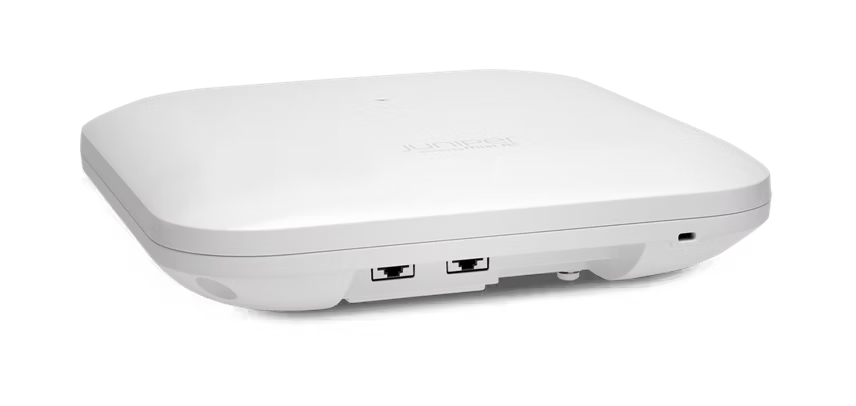The world of wireless networking is constantly changing, and each new Wi-Fi standard marks a major step forward. With Wi-Fi 7, we’re looking at a major leap in wireless communication. Paired with Juniper Networks’ Mist AI platform and the brand-new AP47, this combination promises smarter, faster, and more efficient wireless networks. And while Marvis still can’t make coffee for you (trust me, we’re getting there someday) this is still something to look forward to!

But first the Elephant in the Room: Do we need Wi-Fi 7 now? – aren’t most of us still setting up Wi-Fi 6?
Yes and No – you will see why I see this both ways.
While it’s true that we are all still deploying Wi-Fi 6 and Wi-Fi 7 just came out (more Devices need to follow to use it broadly), Wi-Fi 7 is the next big upgrade in the world of Wi-Fi, building on the features of Wi-Fi 6 (802.11ax) to deliver faster speeds, lower latency, and greater reliability. With Wi-Fi 7 you can reach speeds up to 30 Gbps (that is if your Access Points and Switches support this) – That’s 3 freaking Fiber-lines from most companies I’ve designed campuses for in the last decade (10G each for those too lazy to calculate) without using a single cable from the Client to the AP – I’m personally always amazed by how fast the technology is evolving… That’s nearly three times faster than Wi-Fi 6. This is thanks to wider channels (up to 320 MHz) and better modulation and compression techniques, which help move data more efficiently. The second major improvement in Wi-Fi 7 is its ability to reduce latency, largely due to multi-link operation (MLO). MLO allows devices to use multiple frequency bands (2.4 GHz, 5 GHz, and 6 GHz) at the same time. This spreads data across different paths, minimizing lag for things like video calls, online gaming, and AR/VR. It allows your Devices to work “smarter” together and allows you to utilize your network to the fullest. Wi-Fi 7 introduces 4K QAM (Quadrature Amplitude Modulation – try saying this fast 5 times in a row to win a fabulous prize – LOL), which can pack more data into each transmission. This means better efficiency and higher capacity, which is critical for handling more devices on the network. Think of this as an upgrade from a shipping perspective: Instead of shipping large boxes, you now ship whole containers – so WAY more data can be transported per waypoint that you have to take in both scenarios. Wi-Fi 7 is also built to work well in crowded places like stadiums, malls, or busy offices – basically the “End-Boss” for every Wi-Fi Engineer (the Elden-Ring type of Boss). With Multi-RU (Resource Unit) technology, it can handle multiple devices at once without slowing down, making it ideal for high-density areas. From a security perspective, Wi-Fi 7 strengthens your networks with updates to the WPA3 encryption, offering better protection against evolving cyber threats (and please stop using passwords like “Password”). Juniper Networks, known for its AI-driven networking solutions, positions its Mist AI platform as a key enabler of Wi-Fi 7’s full potential. Mist AI combines machine learning with cloud-based architecture to create networks that adjust in real-time based on current conditions – that’s right folks: REALTIME (that’s LIVE for those who don’t know what real-time means) :O
Juniper Mist reduces the need for manual network management. Its AI automatically optimizes Wi-Fi 7 networks, ensuring efficient use of bandwidth, minimizing congestion, and keeping connections stable while at the same time not making you as an admin “obsolete” (no worries, no one will take your Job) – instead, you can finally focus on the Design of your network and Juniper Mist will even give you “hints” where to look at when planning, designing and operating wireless networks no matter small or HUGE. This takes the pressure off IT teams, letting them focus on more important tasks. It also helps your users, as you typically see issues already before they can even pick up the phone to report it. Imagine switching from “Oh No! Let me check that” to “Boooooooring! Already known, already fixed” – wouldn’t that be awesome? By constantly analyzing network performance, Marvis (Junipers AI if you don’t already know) ensures users enjoy a reliable and high-quality connection. It can shift resources or balance traffic as needed, so even in high-traffic environments, users get the best experience possible. Acting like a virtual IT expert, Marvis can provide natural language troubleshooting and make recommendations to optimize the network, offering valuable support to IT teams. Juniper Mist operates exclusively in the cloud management wise (sorry on-prem folks), making it scalable for businesses with multiple locations. Whether managing a small office or a large enterprise with hundreds or thousands of distributed networks, Juniper Mist offers centralized control with local optimization.
As Wi-Fi 7 now becomes available, various industries will benefit from the combination of this next-gen Wi-Fi standard and AI-powered network management. This is just what comes to my mind fast:
+ In offices where many devices are connected at once, Wi-Fi 7’s speed and capacity will shine. Juniper Mist AI will ensure efficient network operation, reducing downtime and resolving issues automatically.
+ In healthcare, where uninterrupted low-latency communication and connectivity are crucial, Wi-Fi 7 will support real-time monitoring, access to patient records, and telemedicine. Mist AI can prioritize medical devices, ensuring they stay connected without interruptions. Additionally, Wi-Fi 7s improved power efficiency helps extend the battery life of wearable health devices, making continuous patient monitoring more feasible and effective. Combine that with MISTs location-based services and you have the currently best possible solution for your patients with unmatched user experience.
+ Schools and universities will see the benefit of Wi-Fi 7’s ability to handle large numbers of simultaneous connections. Mist AI will help maintain a stable network for students and staff, even during peak usage times.
+ With smart cities increasingly relying on IoT devices, Wi-Fi 7 provides a robust infrastructure to support these technologies. Mist AI helps scale networks while maintaining performance as the number of connected devices grows.
+ Customer-facing industries like retail and hospitality can use Wi-Fi 7 to enhance mobile payments, digital signage, and customer experiences. Mist AI ensures any network issues are quickly resolved, minimizing downtime during critical operations.
I hope you can see now, why my initial answer was a Yes and No type.
Wi-Fi 7 isn’t just a small upgrade—it’s a reimagining of wireless networks to meet future demands. As businesses and consumers seek faster, more reliable, and secure wireless connections, the combination of Wi-Fi 7 and AI solutions like Juniper Mist points the way forward for the next decade of wireless technology. Looking ahead, the true power of Wi-Fi 7 will be realized when it integrates with other emerging technologies like 5G or IoT, creating a seamless, hyper-connected world. For companies looking to stay ahead, adopting Wi-Fi 7 and Juniper Mist AI is a key step in future-proofing their networks.

Want to learn more about the AP47? Check out the Product page here: https://www.juniper.net/us/en/products/access-points/ap47-access-point.html
Happy Hacking folks 😊
Pingback: permit-any-any.comWi-Fi 7 and Juniper Mist: The Next Evolution in Wireless Networking